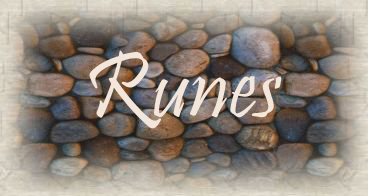


The History of the Runes - Unlocking the Mystery of the Runic Sigils by Faith Lamb
(submitted 2009-05-27)
The history of the Runes is steeped in mystery and secrecy, with many scholars today arguing the case for different origins and purposes. For over two thousand years Runes have held a fascination with people, holding a sense of magic and wonder. For an alphabet to have gained this aura of mystery seems perhaps odd, yet Runic history shows that these symbols were not created purely as an alphabet with which to communicate, but as symbols of the world around them, including the unseen forces.
Legend tells that the history of the Runes begins with Odin, the mighty God of the Norse mythology. It is said that Odin hung from the World Tree, upside down, for nine days and nine nights, after which he died. As he passed on to the realm beyond death he gained knowledge and understanding beyond that of mortals, after which he was reborn. His knowledge was then passed on in the form of Runes.
The very word, 'Rune' means 'shrouded in mystery' or 'hidden wisdom', and so it is unsurprising that much speculation and disagreement exists today as far as some of the origins and deeper meaning of the Runes is concerned. We do know that some of the Runic symbols are very old, found in carvings from the Bronze Age, and it is interesting to note that several of these have survived to current alphabets in very similar forms.
The use of Runes today as a means of divination is not new, since this was one aspect of the Runes which was used widely between one and two thousand years ago. In addition to being used as a means of divination or fortune telling Runes were also used as part of magical rituals and spells. About a thousand years ago the Roman Empire was spreading the use of its own alphabet very widely and successfully, which led to the relative demise of Runes as an alphabet, with their meaning and knowledge handed down the generations in ways which heightened their secrecy and mystery.
But this knowledge and history of the Runes has survived down the ages, and has seen recent revivals which have helped to shed more light on this fascinating alphabet, and on its people. The Runic alphabet is not merely a collection of symbols which may be used in the creation of words or as a means of divination. Many Runic symbols reflect the deep beliefs of the people who created and used them, shedding light on the aspects of the world around them which were of prime importance. If Runic history has taught us anything today, then it is that the people who developed and used this alphabet were deeply connected to the realm of the spirit and to the natural world than we are today.
It is perhaps this undercurrent of mythology entwined with the relationship between Runes and both the natural world and the spiritual realm that has helped encourage their widespread use today. In a world of unseen digital information, wireless transmissions flying above our heads and gigabytes of data at our fingertips should we ask the right questions, we have found ourselves in a world where the unseen powers which bind us together are rooted more and more firmly in our own technology. Yet this can be deeply unsettling, and more and more of us are finding the need to explore a more spiritual dimension, even if that is little more than learning to see aspects of the world through the symbols and language of a people who achieved what today we can only dream of.
The history of Runes, as with our own language, draws together aspects from several paths and cultures, with some symbols being remarkably similar to Italic and Latin scripts, whilst others are entirely unique when compared to letters from any modern language. It is often the case that these unique symbols reflect aspects of the natural or spiritual worlds in ways which we are only recently beginning to piece together.
The Runic alphabet is more often referred to as the Futhark, and this is the more accurate term for the collection of Runic symbols. The word 'alphabet' simply derives from the first two letters of our own alphabet - alpha, beta. In the same way, the Futhark is also derived from the first few letters of the Runic sequence of symbols. However, there do appear to be a number of different Futhark variations, and if you are investigating Runic history you will notice that the two main versions are the Elder Futhark and the Younger Futhark.
The Elder Futhark is, and the name suggests, the older version which consists of 24 letters of symbols, although in Medieval Europe, and England in particular, this was extended to 33 symbols. The Younger Futhark, predominantly developed around the 17th century, is a much reduced form, comprising only 16 symbols.
The history of the Runes reveals that, unlike Tarot cards, Runic symbols provide far more than merely a means of divination, but that they hold secrets impenetrable even to today's scholars, and a mystery which has existed for thousands of years. Whether as a fascinating relic of a culture and language long gone, a symbol of the mystery and magic which has threatened the establishment across half the civilised world in its time, or as a means of divination which harnesses visions of a natural and spiritual realm realised by its creators, Runes today are more popular than at any time in their history.